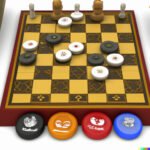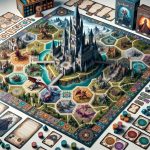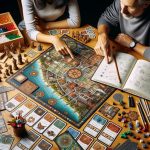Are you a fan of strategy war board games and have you ever wanted to create your own? In this article, we will explore the process of how to make a strategy war board game from start to finish.
Strategy war board games have long been popular among gamers for their immersive gameplay and strategic challenges. Creating your own game not only allows you to unleash your creativity but also gives you the opportunity to share your unique vision with others.
Before diving into the details of game creation, it’s important to understand the appeal of strategy war board games. These games are known for their ability to engage players in complex decision-making and tactical maneuvers, often simulating historic battles or fictional conflicts. By creating your own strategy war board game, you can tailor the experience to match your interests and offer a fresh perspective on the genre.
One of the benefits of creating your own strategy war board game is the freedom to design gameplay mechanics and rules that reflect your creative vision. With careful research and planning, you can craft a game that offers unique challenges and rewards for players.
Throughout this article, we will explore each step of the game creation process, from initial concept development to production and distribution options. Whether you’re an aspiring game designer or simply passionate about strategy war board games, this guide will provide valuable insights into bringing your ideas to life.
Research and Inspiration
Researching existing strategy war board games and drawing inspiration from them is an essential part of the game development process. By studying the mechanics, themes, and components of successful games in this genre, you can gain valuable insights that will help you create a unique and engaging game of your own.
Studying Existing Games
Start by playing a variety of strategy war board games to understand what makes them enjoyable and challenging. Take note of the game mechanics, such as resource management, combat systems, and win conditions. Pay attention to how these mechanics contribute to the overall experience and consider how you can adapt or innovate on them in your own game.
Finding Inspiration
In addition to playing existing games, research the history and themes commonly portrayed in strategy war board games. Look for inspiration from historical battles, mythologies, or fictional universes that resonate with players. Explore different settings and time periods to find a theme that will stand out in a crowded market.
Adapting Ideas
While it’s important to draw inspiration from existing games, it’s equally important to bring your own ideas and creativity to the table. Consider how you can put a fresh spin on traditional game mechanics or introduce innovative concepts that will set your game apart. By blending established elements with original ideas, you can create a strategy war board game that feels familiar yet exciting for players.
Game Concept and Theme
When creating a strategy war board game, coming up with a unique and engaging concept is crucial to its success. The concept of your game sets the stage for everything else that follows, from the mechanics and rules to the art and design.
To begin brainstorming for your game concept, it’s essential to think about what makes your game different from existing titles in the genre. Consider what kind of experience you want players to have when playing your game and how you can achieve that through your concept.
Research Existing Games
One way to come up with a unique concept is to research existing strategy war board games. By familiarizing yourself with what’s already out there, you can identify gaps in the market or areas where you can put a new spin on an existing idea.
This research will also help you understand what players enjoy about strategy war board games and what keeps them engaged. You can draw inspiration from successful games while also identifying opportunities to offer something fresh and exciting.
Choosing a Theme
Once you have a solid concept for your game, choosing a theme that resonates with players is crucial. The theme sets the tone for the entire experience and can make your game more appealing to potential players. Whether it’s historical warfare, futuristic battles, or fantasy realms, the theme should be integrated into every aspect of the game – from the art and design to the components and gameplay.
Consider what themes are popular in strategy war board games and how you can put your own unique twist on them to create something that stands out. By crafting a compelling concept and theme, you can lay the foundation for a strategy war board game that captures players’ imaginations and keeps them coming back for more.
Game Mechanics and Rules
When making a strategy war board game, it is crucial to have a solid understanding of the game mechanics and rules. These elements are the foundation of the game and are essential for providing structure and ensuring a balanced and fair playing experience for all participants. Here are some key considerations for developing the game mechanics and rules for your strategy war board game:
- Victory Conditions: Determine the specific conditions that will lead to victory in the game. Whether it’s capturing a certain territory, eliminating opponents’ units, or achieving specific objectives, clearly defined victory conditions will give players a clear goal to strive for.
- Unit Abilities and Attributes: Define the abilities and attributes of different units in the game. Whether it’s infantry, cavalry, or special units with unique abilities, having well-defined unit characteristics will add depth and complexity to the gameplay.
- Action Economy: Establish rules around how players can take actions during their turns. This can include limitations on movement, combat, resource management, or any other actions that drive the strategic decision-making within the game.
- Balance and Fairness: One of the most crucial aspects of designing game mechanics and rules is ensuring balance and fairness. All players should have an equal opportunity to succeed, without any one strategy or tactic dominating the game. This can be achieved through playtesting and iteration to identify any imbalances and address them accordingly.
Creating engaging and well-balanced game mechanics and rules is integral to crafting an immersive strategy war board game that will captivate players. By carefully considering these elements during the design process, you can ensure that your game provides an enjoyable experience for all participants while also offering strategic depth and complexity.
Board and Components
When creating a strategy war board game, one of the most important elements is the design of the game board and components. The game board serves as the battlefield where players will strategize and compete, while the components such as tokens, cards, and dice are essential for gameplay. Designing these elements requires careful consideration of materials, techniques, and visual appeal.
First, consider the size and shape of your game board. Will it be modular or fixed? What kind of terrain or features will it have? Depending on your theme, you may need to incorporate different environments such as forests, mountains, or cities. Consider using materials like thick cardboard or game board stock for durability. For components such as tokens and cards, choose materials that can withstand frequent handling without wearing out quickly.
In addition to materials, consider incorporating different design techniques to enhance the aesthetics of your game board and components. Utilize graphic design software for creating visually appealing artwork that reflects your chosen theme. Consider using illustrations or symbols that are clear and easy to distinguish during gameplay.
Ultimately, carefully designing and creating the game board and components is crucial in making a strategy war board game that is visually engaging and functional for players to immerse themselves into the game’s world.
| Element | Description |
|---|---|
| Game Board | Consider size, shape, terrain features; use durable materials like cardboard or game board stock |
| Game Components | Choose materials that can withstand frequent handling; utilize graphic design software for aesthetic artwork |
Prototyping and Testing
Once you have a solid concept and an understanding of the mechanics and rules for your strategy war board game, it’s time to move on to the prototyping and testing phase. This is a crucial step in the game development process as it allows you to identify any flaws or issues with your game before moving on to production. Here are some tips for prototyping and testing your game:
- Create a rough prototype: Use whatever materials you have on hand to create a rough version of your game. This could involve printing out cards, using cardboard for pieces, or even making a simple mock-up of the game board. The key is to create something that you can playtest with.
- Playtest with friends and family: Gather a group of friends and family members who are willing to playtest your game. Watch them as they play and take note of any problems they encounter, confusion over rules, or areas where the gameplay could be improved.
- Iterate and refine: Based on feedback from playtesting, make changes to your game. This could involve tweaking rules, adjusting balance, or even completely redesigning certain aspects of the game. Then, test these changes again with a new group of playtesters.
Remember that prototyping and testing is an iterative process – it may take several rounds of testing and refinement before your game is ready for production. Don’t be discouraged by initial feedback, as this is all part of the creative process when developing a strategy war board game.
Overall, prototyping and testing are essential steps in creating a successful strategy war board game. By gathering feedback from playtesters and iterating on your design, you can address any flaws or issues before moving on to production. The key is to be open-minded and willing to make necessary changes based on feedback in order to create an engaging and balanced gaming experience for players.
Art and Design
When creating a strategy war board game, one of the most crucial aspects to consider is the art and design. The visual appeal of a game can greatly impact its success, as it can draw in players and enhance their overall gaming experience. To begin, it’s important to establish a cohesive theme that runs throughout the entire game, from the board to the components. This theme should be visually stimulating and engaging for players.
In terms of actual design, clarity is key. It’s essential that all components of the game are visually clear and easily distinguishable. This includes using color palettes that complement each other rather than clash, as well as choosing fonts and symbols that are easy to read and understand.
Additionally, it’s crucial to consider accessibility when designing the art for your strategy war board game. Ensuring that visuals are not only clear but also inclusive to all players will make your game more appealing to a wider audience.
One effective way to approach art and design is by collaborating with a professional artist or graphic designer. Their expertise can elevate the visual aspect of your game while ensuring a cohesive and polished look throughout. Ultimately, clear and cohesive visuals will not only enhance the aesthetic appeal of your strategy war board game but also contribute to an overall positive gaming experience for players.
| Strategy War Board Game Design | Importance |
|---|---|
| Cohesive Theme | Visually stimulating and engaging for players |
| Clarity in Design | Easy to read, understand, and accessible to all players |
| Professional Collaboration | Elevate the visual aspect of the game |
Production and Distribution
In conclusion, creating a strategy war board game can be a rewarding and immersive experience for game enthusiasts. By following the steps outlined in this guide, from researching existing games to prototyping and testing your own, you can bring your unique vision to life.
The process of coming up with a concept, designing game mechanics and rules, and crafting the board and components is not only a creative endeavor but also an opportunity to engage with friends and family in playtesting sessions.
Once your game is ready for production, there are various options to consider for bringing it to the market. Self-publishing allows for complete creative control and flexibility in terms of distribution. However, working with a publisher can provide access to broader audiences and resources for marketing and production. It’s important to carefully weigh these options based on your goals for the game and make an informed decision that aligns with your vision.
Ultimately, whether you choose self-publishing or collaboration with a publisher, seeing your strategy war board game come to life is an accomplishment worth celebrating. From conceptualizing the game’s theme to designing its components and navigating the production process, creating a strategy war board game offers a unique blend of creativity, strategic thinking, and craftsmanship. With dedication and careful planning, anyone can bring their own unique vision of a strategy war board game into reality.
Frequently Asked Questions
How to Make a Board War Game?
Making a board war game requires careful planning and consideration of the game’s theme, mechanics, and balance. Researching historical battles, creating engaging artwork, and testing the game for balance are all crucial steps in the process.
How Do You Create a Strategic Game?
Creating a strategic game involves balancing elements such as resource management, player interaction, and decision-making. It’s important to design clear rules and win conditions while also allowing for emergent strategies to keep the game interesting and replayable.
What Makes a Good Strategy Board Game?
A good strategy board game offers meaningful choices to players, has a well-balanced design that allows for multiple viable paths to victory, and provides an engaging experience that keeps players thinking and strategizing throughout the game. Additionally, a well-designed theme and components can add immersion and enjoyment to the overall experience.

I love playing all kinds of games – from classics like Monopoly to modern favourites like Ticket to Ride.
I created this blog as a way to share my love of board games with others, and provide information on the latest releases and news in the industry.





